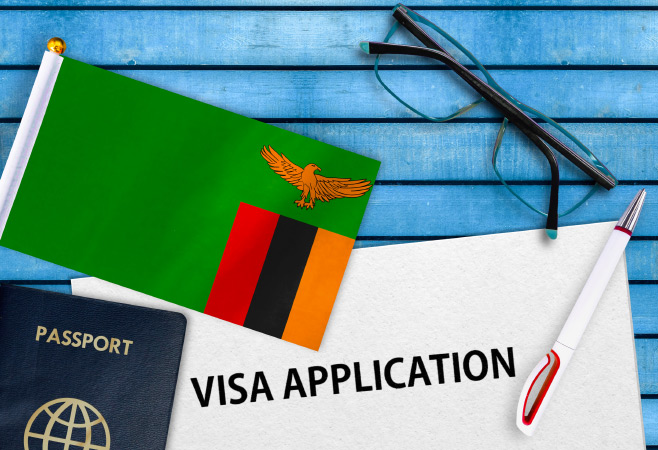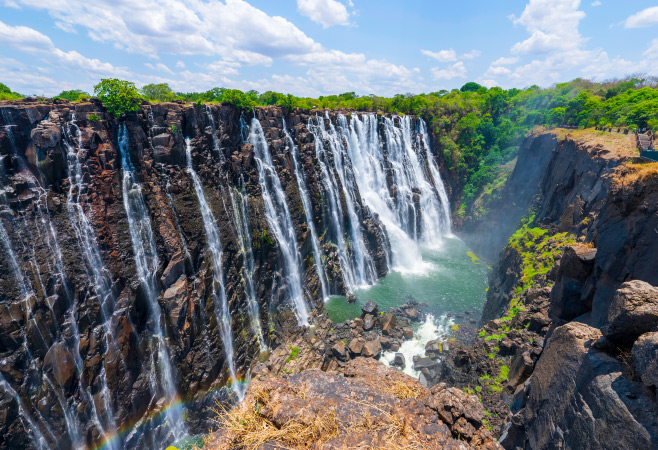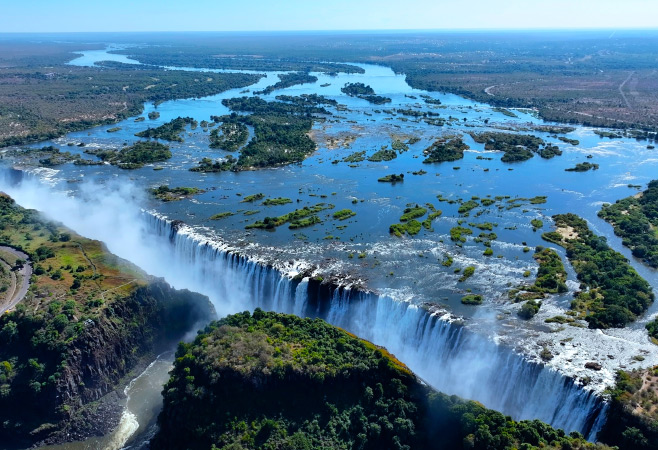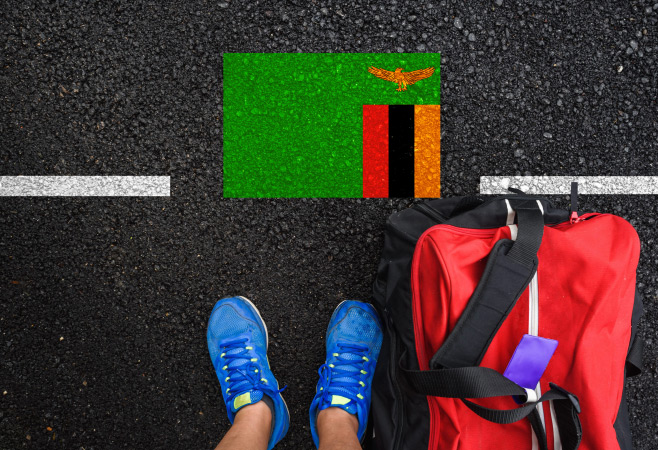Zambia eVisa (online visa) or visa on arrival: Key differences
Traveling to a foreign country legally requires preparation and awareness of immigration procedures. Zambia is a well-known Southern African country with Victoria Falls and a variety of safari parks, which provide two primary visa options to foreigners: The Zambia eVisa (electronic visa) and the visa on arrival. This article offers a legal and procedural comparison of these visa types, their corresponding eligibility criteria, costs and the most suitable one depending on your travel intent.

Visa application form and flag of Zambia
Overview of Zambia eVisa
What is Zambia eVisa?
Zambia eVisa is a pre-arrival e-travel authorization that enables foreigners to visit the country without having to visit any physical consulate. It is part of Zambia’s modernized immigration system, which seeks to simplify legal entry.
Eligible countries for Zambia eVisa
The Department of Immigration in Zambia has accepted a very long list of countries that can apply to get an eVisa. These are the citizens of the United States, the United Kingdom, Canada, India, Australia and EU member states among others. Eligibility in full is posted on the official eVisa site of Zambia Immigration.
How to apply for eVisa to Zambia
The eVisa application process is entirely digital. Here’s a breakdown:
- Visit the Zambia eVisa portal: Create an account and select visa type (single, double or multiple entry).
- Upload required documents: These typically include a valid passport (6+ months validity), passport photo, flight itinerary, hotel bookings and a cover letter for business travel.
- Payment of fees: Zambia eVisa cost varies by nationality and visa type.
- Receive approval: Processing takes 3–5 working days.
- Print approval letter: Present it to border authorities upon entry.

View of the Victoria Falls, Livingstone, Zambia
Zambia eVisa cost and validity
- Single entry eVisa: Approx. USD $50
- Double entry eVisa: Approx. USD $80
- Multiple entry eVisa: Approx. USD $150
Validity ranges from 30 to 90 days, subject to immigration officer discretion.
eVisa Zambia immigration requirements
Applicants must meet the following conditions:
- No prior deportations or immigration offenses in Zambia.
- Evidence of return or onward travel.
- Proof of accommodation and sufficient funds.
- Intent of visit must match declared purpose (tourism, business, transit).
Overview of Zambia visa on arrival
What is the Zambia visa on arrival?
The Visa on Arrival is a form of entry clearance granted at designated border checkpoints upon landing. It serves travelers from select countries who either lack eVisa access or are from countries eligible for both but prefer convenience at the border.
Zambia visa on arrival countries
Nationals of countries such as South Africa, Kenya, Tanzania, Zimbabwe and some EU and Commonwealth nations are permitted to obtain a visa upon arrival. This privilege is subject to bilateral agreements and may be revoked without prior notice.
Lusaka visa on arrival process
At Kenneth Kaunda International Airport (Lusaka), the process is as follows:
- Arrival and passport presentation
- Filling out arrival card
- Payment at visa desk: Accepted in USD.
- Visa stamp issued in passport
Processing time may vary depending on arrival volume.
Visa on arrival in Zambia: Duration and fees
- Fee: Typically USD $50 for single entry.
- Validity: Usually up to 30 days.
- Extensions: Available at Zambia Immigration Offices, subject to justification.

Victoria Falls at Livingstone, Zambia
Legal comparison: eVisa vs visa on arrival
Application procedures
- eVisa: Pre-travel documentation, remote approval.
- Visa on Arrival: On-site application, immediate evaluation.
Legally, both confer temporary resident status but differ in scrutiny levels.
Legal status upon entry
With an eVisa, the traveler arrives with pre-vetted credentials, reducing discretionary denials at entry. Visa on arrival entails real-time decision-making, increasing exposure to border control discrepancies.
Border control and entry risks
While both visa types are valid, visa on arrival introduces a risk of entry denial if supporting documents (e.g., insufficient funds or unclear intent) are deemed unsatisfactory. Legally, the immigration officer holds broad discretionary powers.
Recommended use cases
- eVisa is legally advisable for business travelers and tourists requiring smoother transit.
- Visa on Arrival may suit regional travelers with short notice plans or border crossers with proven eligibility.
Which one should you choose? A legal perspective
Risk mitigation for business and tourism travelers
For travelers requiring guaranteed access (conference attendees, investors, tour groups), the eVisa is the preferred legal route. It minimizes delays and ensures documentation has been previously verified.
Consular advice and best practices
Attorneys and consular services frequently recommend that foreigners consider requesting the eVisa when it is offered. Although visa on arrival is legal, it brings in border discretion that is unpredictable. Applying early through the eVisa portal provides a formal documentation of the travel intent which is useful during immigration audit or legal appeal.

Zambia welcome sign post travel immigration
FAQs
- Can I switch from a visa on arrival to a multiple-entry eVisa once in Zambia?
No. Visa types are not convertible inside Zambia. You must exit and reapply via the eVisa system.
- How long does Zambia eVisa processing usually take?
Processing typically takes 3–5 business days. Applicants are encouraged to apply at least 7 days in advance.
- Are all border posts in Zambia equipped for visa on arrival?
No. Visa on arrival is only available at designated ports of entry such as Lusaka Airport, Livingstone Airport and major land crossings.
- What is the difference in legal protection between eVisa and visa on arrival?
The eVisa offers pre-authorized entry, reducing the likelihood of discretionary denial. A visa on arrival does not offer the same legal cushion.
- Is the Zambia eVisa refundable if denied?
No. Visa fees are non-refundable under Zambian immigration law, regardless of outcome.

A man is standing on asphalt next to flag of Zambia and border
Conclusion: Simplifying Zambia entry decision
The eVisa and Visa on Arrival of Zambia are both legal tools of entry to the country. But in terms of risk management, compliance and efficiency of processing the eVisa has a better legal advantage. It is consistent with the international good practice and reduces ambiguities that are involved in border assessments. Exigent circumstances notwithstanding, the use of the Zambia eVisa platform by travelers is highly encouraged to promote a compliant and secure travel.
Related Articles
- Air Charter Zambia: Tourist guide to flights, safaris & transfers
- Ngonye Falls: Zambia’s natural beauty and cultural heritage
- Luambe National Park: Discover Zambia’s untouched wilderness
- Lavushi Manda National Park: Zambia’s hidden gem
- Sioma Ngwezi National Park: Wildlife and travel guide in Zambia




